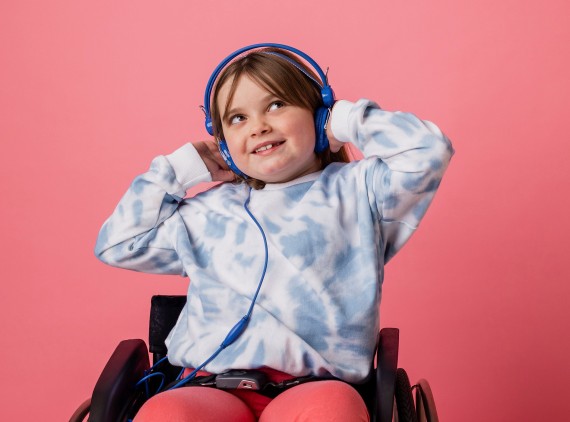Dystonia is an often-misunderstood neurologic condition.
Dr. Michael Kruer, director of the Pediatric Movement Disorders Program at Barrow Neurological Institute at Phoenix Children’s, shared a relatable analogy for this complex medical condition, “If you’ve ever experienced a charley horse, you’ve experienced a mild form of dystonia.”
What families need to know about dystonia
Dystonia is a movement disorder that can impact people at any age. A neurological condition, dystonia causes signals from the brain to become “out of sync,” causing involuntary muscle contractions. Individuals who have dystonia may experience uncontrollable twisting or tremors, repetitive movements, or abnormal and often painful postures. Using Dr. Kruer’s example, dystonia can feel like an intense muscle cramp that doesn’t go away.
Dystonia affects 250,000 people in the U.S., making it the third most common movement disorder behind essential tremor and Parkinson’s disease. Still, a lot of families in our community aren’t familiar with this condition.
Many aspects of this neurological movement disorder make it complex. There is no single cause of dystonia. It may be genetic, or it could result from a traumatic brain injury or stroke. For some individuals, a cause may not always be identified. Dystonia can often be debilitating and can impact any part of the body — including arms, and legs, head and neck, and even specific muscle groups like vocal cords.
Unlike many health conditions that cause chronic symptoms, the intensity of dystonia can vary over time. “Many kids with dystonia can have chronic, near-constant symptoms but also have symptoms that come and go. Their symptoms can get much worse when they are sick or stressed and can be triggered by common things like a touch, a startle, or emotion,” said Dr. Kruer.
Neurological and neurosurgical treatment can relieve dystonia symptoms
While there is no cure for dystonia, advancements in medicine and technology enable providers like Dr. Kruer to help patients find relief from their uncomfortable symptoms. For some, prescribed medications and/or botulinum toxin injections can help provide relief. For more severe cases, deep brain stimulation (DBS) has long been an effective surgical treatment for adults. Phoenix Children’s is on the leading edge of performing DBS to help children with dystonia and other pediatric movement disorders. “We’re one of a handful of health systems that offer pediatric DBS,” said Dr. Kruer. “DBS is a form of neuromodulation that uses technology to help brain cells to fire more normally.”
During a DBS procedure, surgeons at Phoenix Children’s implant tiny electrodes (thin, flexible wires) into specific areas of a child’s brain that control movement. Surgeons then implant a small pacemaker-like device, called a neurostimulator, under the skin of the child’s chest below the collarbone. Once programmed by a neurologist, the neurostimulator delivers steady electrical pulses to correct any abnormal or overactive brain rhythms that are causing involuntary muscle contractions and movements.
Following surgery, a pediatric movement disorders neurologist will continue to monitor the device’s activity and make any necessary adjustments during routine follow-up visits. As an added benefit, DBS may eliminate the need for some patients’ prescribed medications.
Targeting DBS at the source in real-time
While DBS has revolutionized the treatment of movement disorders, it’s not without its limitations. “One of the biggest challenges we’ve faced with DBS is that there is a delay between when we program a child’s neurostimulator and when the dystonia improves. It doesn’t usually happen right before our eyes – it often takes days or weeks for the movement disorder to improve. This ‘set-check-adjust’ process can take several weeks, which impacts our patients’ quality of life,” shared Dr. Kruer.
Phoenix Children’s found a solution. “We employ the latest technology that enables us to monitor and record a child’s brain rhythms while the neurostimulator delivers its corrective pulses. Using BrainSense™ technology, we can see on our tablet exactly where the abnormal electrical signals are coming from,” said Dr. Kruer. “We describe it to kids as a way for their brains to talk to us. There have actually been times when I’ve been able to show my patients the source of their movement disorder during their appointment. Having such exact information has been an absolute game changer. We can make adjustments during their visits and immediately see the results on the monitors, which is enabling us to optimize their settings much faster.”
Advocating for DBS to benefit children worldwide
At Phoenix Children’s, we want children with dystonia or other movement disorders to have the opportunity to benefit from optimized DBS. That’s why we’re part of PEDiDBS — an international consortium of health systems that collects and shares clinical data, and partners with other doctors and scientists to study how best to use DBS technologies to help kids. “It’s really an exciting time as technology breakthroughs offer more and more tools that enable us to enhance care for children,” said Dr. Kruer.

